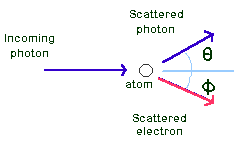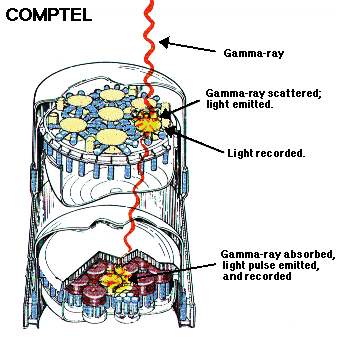

Compton scatter telescopes have been largely experimental in design. The most advanced and successful instrument is the so-called COMPTEL (COMPton TELescope) aboard NASA's Compton Gamma-Ray Observatory.

| As shown in the picture above, the line between these two interaction points does not point back to the direction of the incoming photon. It is possible, however, to determine the angle of incidence the cosmic photon made with respect to this line because the Compton scattering law provides for a definite relationship between this angle and the energy of the scattered photon (measured in the second level) and the scattering electron (measured in the first level). Unfortunately, while this angle is calculable, you cannot determine which azimuthal direction the photon came from. As a result, the gamma-ray could have come from anywhere in a ring on the sky, which makes analyzing Compton telescope data particularly challenging. |
|
Energy resolution is fairly good for these detectors, typically 5-10%. This is limited by uncertainties in the measurements of the energy deposited in each layer. Compton scatter telescopes have wide fields-of-view and can form images even though the so-called point spread function (the probability that an event came from a certain area on the sky) is a ring.
Any Suggestions, mail to: emrah@astroa.physics.metu.edu.tr